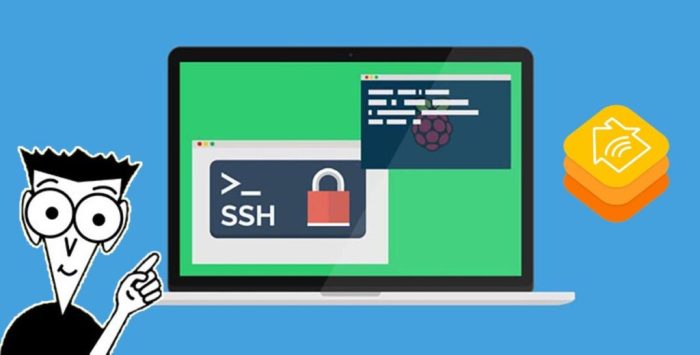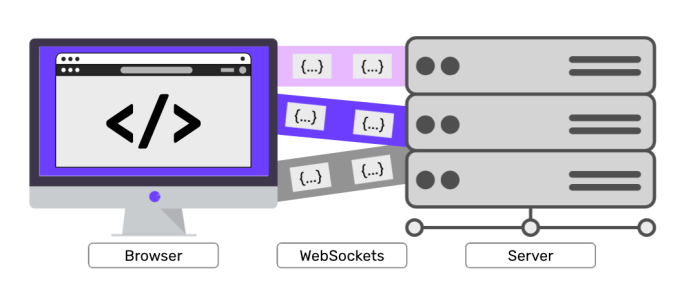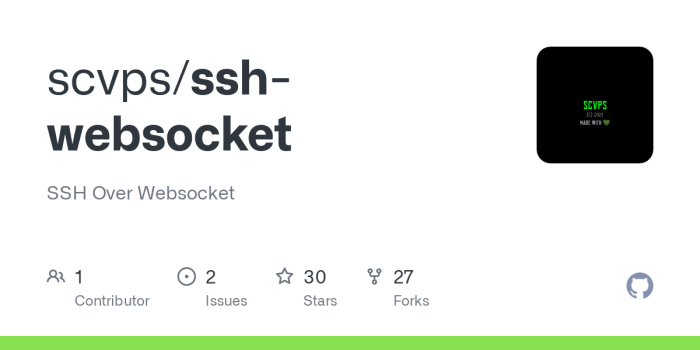In the realm of remote access, the advent of SSH Websockets has revolutionized the way we connect to and manage remote systems. By seamlessly bridging the gap between the venerable SSH protocol and the ubiquitous WebSockets technology, SSH Websockets empower us with unprecedented flexibility, security, and performance.
This innovative approach offers a multitude of benefits, ranging from enhanced user experience and reduced latency to improved security and compatibility. As we delve into the intricacies of SSH Websockets, we will explore its technical implementation, security considerations, and a wide array of use cases.
Introduction to SSH Websocket
SSH (Secure Shell) is a network protocol that provides a secure channel over an unsecured network. It is commonly used for remote login and command execution. WebSockets are a communication protocol that enables bidirectional communication between a client and a server over a single TCP connection.SSH
over Websockets combines the security and reliability of SSH with the real-time capabilities of WebSockets. This allows for secure, real-time communication between a client and a server, even over unreliable networks.
Benefits of Using SSH over Websockets
Using SSH over Websockets offers several benefits, including:
- Security: SSH provides strong encryption and authentication, ensuring that data transmitted over the connection is secure.
- Real-time communication: WebSockets enable bidirectional communication in real time, making them ideal for applications that require continuous data exchange.
- Cross-platform compatibility: SSH and WebSockets are supported by a wide range of platforms and devices, making it easy to establish secure connections between different systems.
Technical Implementation
Setting up an SSH Websocket connection involves establishing a secure channel between a client and a server over a WebSocket protocol. Here’s a simplified overview of the process:
1. -*Client-side: The client initiates a WebSocket connection to the server using a WebSocket library. It sends an SSH handshake message, including its SSH version, cipher algorithms, and compression methods.
2. -*Server-side: The server receives the SSH handshake message and responds with its own SSH handshake message, negotiating the connection parameters.
3. -*Secure Channel: Once the handshake is complete, an encrypted SSH channel is established over the WebSocket connection. This channel provides a secure tunnel for SSH traffic.
4. -*SSH Commands: The client can now send SSH commands over the WebSocket connection, and the server will execute them and return the results.
Code Examples
Here are some examples of code for implementing SSH Websockets in different programming languages:
- Python:
“`python
import asyncio
import websockets
import paramikoasync def main(): uri = “wss://example.com:2222/ssh” async with websockets.connect(uri) as websocket: transport = paramiko.Transport(websocket) transport.start_client() session = transport.open_channel(“session”)session.exec_command(“ls -la”) result = session.recv(4096).decode() print(result)asyncio.run(main()) “`
- JavaScript: “`javascript import WebSocket from “ws”;const websocket = new WebSocket(“wss://example.com:2222/ssh”);websocket.onopen = () => // Send SSH handshake message websocket.send(“SSH-2.0-OpenSSH_8.2p1 Ubuntu-4ubuntu0.3”); ;
websocket.onmessage = (event) => // Handle SSH server handshake message const data = event.data; // … ; “`
Security Considerations
Using SSH Websockets introduces certain security implications that must be carefully considered and mitigated.
The primary concern is the potential for eavesdropping on SSH traffic by unauthorized third parties. To address this, SSH Websockets should be deployed over a secure channel, such as HTTPS or WSS (WebSocket Secure), to ensure that the traffic is encrypted.
Authentication and Authorization
Another security consideration is ensuring that only authorized users can access SSH Websocket connections. This can be achieved through a combination of strong authentication mechanisms, such as public key cryptography, and role-based access control (RBAC) to restrict access to specific resources or commands.
Use Cases

SSH Websockets find applications in various scenarios, offering benefits such as remote access, secure data transfer, and improved user experience.
One notable use case is enabling secure remote access to servers or cloud environments. By establishing an SSH connection over a websocket, users can access and manage remote systems from anywhere with an internet connection. This eliminates the need for traditional VPNs or other complex network configurations, simplifying remote access.
Web-based SSH Terminals
SSH Websockets empower web-based SSH terminals, allowing users to access and interact with remote servers directly from their web browsers. This eliminates the need for dedicated SSH clients and provides a convenient and accessible interface for remote system administration.
Secure Data Transfer
SSH Websockets can facilitate secure data transfer between devices. By establishing an encrypted channel over a websocket, users can securely transfer files, sensitive data, or perform remote backups without exposing sensitive information to unauthorized parties.
Improved User Experience
SSH Websockets enhance user experience by providing a more responsive and interactive remote access experience. By leveraging the real-time capabilities of websockets, SSH Websockets enable instant updates, faster command execution, and a seamless user interface.
Performance Optimization

Optimizing the performance of SSH Websocket connections is crucial for ensuring a seamless and responsive user experience. Several techniques can be employed to reduce latency and improve throughput, thereby enhancing the overall efficiency of the connection.
One key factor in optimizing performance is to minimize the number of round-trips between the client and server. This can be achieved by using a technique called “keep-alive,” which maintains a persistent connection between the two endpoints, reducing the need for re-establishing connections for each request.
Buffering
Buffering is another effective technique for improving performance. By buffering data on both the client and server sides, it becomes possible to send and receive larger chunks of data at once, reducing the overhead associated with multiple small packets. This technique can significantly improve throughput, especially for applications that involve transferring large amounts of data.
Compression
Compression algorithms can be employed to reduce the size of data transmitted over the connection. By compressing data before sending it, the amount of data that needs to be transferred is reduced, leading to faster transmission times. However, it’s important to consider the trade-off between compression efficiency and computational overhead, as excessive compression can introduce additional processing delays.
Selecting the Right Server
The choice of server can also impact performance. Factors such as server location, hardware capabilities, and network connectivity can all affect the latency and throughput of the connection. By carefully selecting a server that is geographically close to the client and has sufficient resources, it is possible to minimize latency and maximize performance.
Monitoring and Troubleshooting
Regular monitoring and troubleshooting are essential for maintaining optimal performance. By monitoring key metrics such as latency, throughput, and packet loss, it becomes possible to identify potential bottlenecks and take corrective actions. Additionally, using tools like Wireshark can help in analyzing network traffic and identifying specific issues that may be affecting performance.
Troubleshooting
SSH Websocket connections may occasionally encounter issues. Here are some common troubleshooting tips to help you diagnose and resolve them.
First, verify that your SSH server is properly configured to support WebSockets. Ensure that the “AllowTcpForwarding” and “GatewayPorts” options are enabled in your SSH configuration file.
Identifying Connection Issues
If you’re having trouble establishing a connection, check the following:
- Make sure that the SSH server is running and listening on the correct port.
- Verify that your firewall is not blocking the connection.
- Ensure that the SSH client and server versions are compatible.
Handling Errors
If you encounter errors during the connection process, refer to the error messages for guidance. Common error messages include:
- “Permission denied”: Check the user permissions on the SSH server.
- “Connection refused”: Verify that the SSH server is running and listening on the correct port.
- “Invalid key”: Ensure that the SSH key used for authentication is valid and matches the key on the SSH server.
Performance Issues
If you experience performance issues, consider the following:
- Check the network bandwidth and latency between the client and server.
- Optimize the SSH configuration for performance by adjusting parameters such as compression and encryption algorithms.
- Use a dedicated SSH gateway to improve performance and security.
SSH Websocket Libraries
SSH Websocket libraries enable developers to integrate SSH Websocket functionality into their applications. Here’s a comparison of some popular libraries:
| Library | Features | Performance | Ease of Use |
|---|---|---|---|
| SSH-Websocket | Supports multiple SSH clients, compression, and binary data | High performance, suitable for real-time applications | Easy to integrate, with a simple API |
| Websocket-Stream | Lightweight, supports multiplexing and TLS | Optimized for low-latency connections | Requires some configuration, but provides flexibility |
| Simple-Websocket | Simple and easy-to-use, supports basic SSH functionality | Suitable for non-critical applications | Minimal configuration, straightforward to implement |
SSH Websocket Best Practices
To ensure secure and efficient SSH Websocket connections, it’s crucial to follow these best practices:
Authentication and Authorization
- Use strong authentication mechanisms such as public-key cryptography or multi-factor authentication.
- Implement proper authorization policies to control access to resources.
Encryption
- Use TLS encryption to protect data in transit.
- Consider using SSH certificate authorities to authenticate servers and clients.
Session Management
- Limit the duration of SSH sessions to minimize exposure to potential attacks.
- Implement session idle timeouts to automatically terminate inactive sessions.
Logging and Monitoring
- Enable logging to record SSH Websocket activity.
- Monitor logs regularly for suspicious activity or security breaches.
Network Considerations
- Use firewalls to restrict access to SSH Websockets from untrusted networks.
- Implement rate limiting to prevent brute-force attacks.
Client-Side Considerations
- Use reputable SSH Websocket libraries and keep them up to date.
- Configure clients with secure settings and disable unnecessary features.
Server-Side Considerations
- Harden SSH servers by disabling unused services and protocols.
- Use secure SSH configuration options and keep software up to date.
Additional Tips
- Regularly review and update SSH Websocket configurations.
- Train users on secure SSH Websocket practices.
- Conduct security audits to identify vulnerabilities and improve security posture.
Future of SSH Websockets

SSH Websockets has a promising future with the growing adoption of web technologies and the increasing need for secure remote access.As the technology matures, we can expect to see several advancements and new applications in the future:
Enhanced Security
Future developments in SSH Websockets will focus on enhancing security measures. This may include the implementation of advanced encryption algorithms, multi-factor authentication, and intrusion detection systems to protect against unauthorized access and data breaches.
Improved Performance
Optimizing performance is another key area of future development. By leveraging advancements in network protocols and optimizing code, SSH Websockets can be made even faster and more efficient, enabling seamless remote access even in high-latency environments.
Integration with Cloud Platforms
SSH Websockets is expected to be increasingly integrated with cloud platforms. This integration will allow users to securely access and manage cloud resources, such as virtual machines, storage, and databases, directly from their web browsers.
New Use Cases
As SSH Websockets becomes more accessible and user-friendly, it will find applications in various new use cases. These may include remote collaboration, DevOps, and even gaming, where secure and real-time communication is essential.
SSH Websocket Resources
SSH Websockets offer various resources to support their implementation and usage. These resources include documentation, tutorials, and community forums.
Documentation
- IETF RFC 6455: Provides the technical specification for SSH Websockets.
- SSH.COM Websocket Protocol: Detailed documentation from SSH.COM on the SSH Websocket protocol.
- Azure Kubernetes Service (AKS) SSH Websocket: Documentation from Microsoft on using SSH Websockets in AKS.
Tutorials
- How To Use SSH Websockets to Access a Remote Server: A tutorial from DigitalOcean on using SSH Websockets to access a remote server.
- SSH over Websocket: A tutorial from PhoenixNAP on setting up SSH over Websocket.
- SSH Websocket Tutorial: A video tutorial from Dev Ed on using SSH Websockets.
Community Forums
- SSH.COM SSH Websocket Forum: A community forum for discussing SSH Websockets.
- Server Fault SSH Websocket: A community forum for discussing SSH Websockets on Server Fault.
- Stack Overflow SSH Websocket: A community forum for discussing SSH Websockets on Stack Overflow.
Conclusion
SSH Websockets have emerged as a transformative technology in the realm of remote access. Its ability to seamlessly integrate with existing web applications, coupled with its inherent security and performance advantages, makes it an indispensable tool for system administrators, developers, and end-users alike.
As the technology continues to evolve, we can expect even more exciting developments and applications in the future.